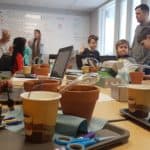📍 Pinnguaq Lindsay Makerspace in Lindsay, Ontario
The Lindsay Makerspace, as its name suggests, is based in Lindsay, Ontario. This central hub of the Trent-Severn Waterway connects 386 kilometres of lakes, rivers and canals on traditional Michi Saagiig territory, and on lands included in the Williams Treaty and Treaty 20. Bounded by watersheds—areas of land where surface water converges, such as shorelines—the region’s naturally occurring ecosystems include forests, wetlands, grasslands and river habitats.
Lindsay’s economy is supported by the Sturgeon Lake watershed through a variety of industries, such as fishing, tourism, recreation, small businesses and other enterprises, including the Lindsay Makerspace. However, the growth of shoreline and urban development, together with the combined impact of agriculture, climate change and invasive species, have increased pressure on the watershed’s aquatic and terrestrial ecosystems. This is affecting the overall health of our community.
Within this context, at the Lindsay Makerspace we see an opportunity to emphasize the role of technology in supporting environmental stewardship. With a mandate to provide a community space for people to gather and explore the connections between thinking, making, playing and sharing, we see the potential to provide young people with agency in the use of technology, to learn as well as to unlearn our role in changing the systems within which we live.
Specifically, we are conscious of the gaps in access to learning and technology that exist for rural and remote communities, especially Indigenous communities and communities of colour. We provide a platform for youth to engage with technology in a participatory and active way, by giving them opportunities to gain skills that are relevant for a future that will be both increasingly digitized and faced with the realities of a changed climate. We seek to create and promote connections among people, technology and the environment.
Coding Roots
One project that sets this in motion is an ongoing, applied community project that is being developed in alignment with the Kawartha Conservation Stewardship Strategy for the Lake Sturgeon Watershed. For the Lindsay Makerspace, we purchased a set of Climate Action Kits, a collection of curricula designed by the tech-ed company Inksmith to work with the BBC micro:bit (a handheld, programmable microcomputer). Our goal was to begin exploring projects connected to the UN’s Sustainable Development goals.
During a Saturday drop-in session, a group of 13 children, ages 4 to 11, planted flowers that are native to the Kawartha Lakes region, such as black-eyed Susan and milkweed. They experimented with coding the micro:bit and connecting the Climate Action Kit’s breakout board and DC water pump to build an automated watering system for their plants. A different version of this project is planned for spring and summer, for which we will conduct coding and electronics activities to support the indoor growth of tree seedlings in the makerspace, leading up to a community planting event in the fall.
For this reforestation project, we are focusing on trees that are considered “advancing species,” which are usually found a little farther south in Ontario. Holly Shipclark, the Stewardship Coordinator at Kawartha Conservation, points out that “it is expected that these tree species, and the organisms that rely on them, will thrive in our ecosystems of the future due to the changing climate. Among others, they include the tulip tree and the swamp oak.” Holly explains that this strategy is termed “assisted migration,” and that it involves acknowledging that, as our environment changes, a different range of species can be integrated into local ecosystems to help them adapt. In Holly’s words: “Future-proofing, but for forests instead of communities!”
With community-based educational projects like these, we hope the Lindsay Makerspace can collaborate with other organizations to channel individual and collective action on issues affecting the local environment, while contributing to strategies meant to safeguard our present and future ecosystems.
Sources: Our Kawartha Lakes Healthy Environment Plan—2019 • Our Kawartha Lakes Integrated Community Sustainability Plan—2014 • Sturgeon Lake Management Plan—2014, Kawartha Conservation • Sturgeon Lake Watershed Characterization Report—2014, Kawartha Conservation

